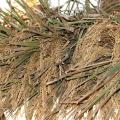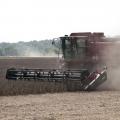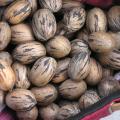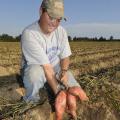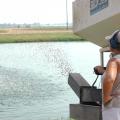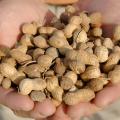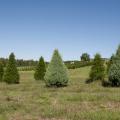Crop Report from 2011
By Karen Templeton
MSU Ag Communications
MISSISSIPPI STATE – The continuing decline of the housing market and the lack of new construction is taking its toll on Mississippi’s turfgrass industry.
Wayne Wells, Mississippi State University Extension turf specialist, said the state’s turf sales are down because of slow home sales and a lack of new construction.
MISSISSIPPI STATE – The yield of early-planted rice looks good so far, but only time will tell how seriously the high heat of early August will cut into yields from later-planted fields.
Nathan Buehring, rice specialist with the Mississippi State University Extension Service, said harvest began in mid-August and will proceed at full speed until completed, probably by the first week of October.
“Those who have a good feel for yield have been pleased with what they’re harvesting so far,” Buehring said. “It won’t be a bumper year, but we should be average.”
MISSISSIPPI STATE -- Mississippi’s cotton has overcome one hurdle after another all season, and fall weather is all that stands between respectable yields and the finish line.
Darrin Dodds, cotton specialist with Mississippi State University’s Extension Service, said “challenging” is the one word that sums up the 2011 cotton crop.
MISSISSIPPI STATE – Tropical Storm Lee brought much-needed rains to Mississippi’s parched fields and pastures but minimal flood and wind damage.
Late-season tropical storms can be costly, even devastating, when winds and pounding rains may whip plants and complicate harvests. When Lee swept through the state over Labor Day weekend, most of Mississippi’s crops either had been harvested or needed one last rain before harvest.
Rainfall amounts…
MISSISSIPPI STATE – Tropical Storm Lee brought rain across the state Labor Day weekend with mixed results -- mostly good -- for the state’s soybean crop.
Rain that weekend ranged from a few hundredths of an inch in northwest Mississippi to as many as 10 inches in some soybean-growing areas. Whether it brought much-needed moisture to dry fields at an ideal time or halted harvest depended on when the crop was planted.
By Karen Templeton
MSU Ag Communications
MISSISSIPPI STATE – The summer drought could have severely affected this year’s pecan yields, but thanks to Tropical Storm Lee, growers are optimistic about the crop.
The entire Southeast experienced a dry growing season until Tropical Storm Lee hit in early September.
“The rains were very timely and needed,” said David Ingram, plant pathologist with the Mississippi State University Central Research and Extension Center in Raymond.
MISSISSIPPI STATE – The state’s sweet potato crop appeared to be doomed before it started, but a late soaking allowed this hardy crop to yield average harvests after a tough year.
Bill Burdine, area agronomic specialist in Chickasaw County with the Mississippi State University Extension Service, said quality may be slightly above average for this crop, which started a little behind schedule.
MISSISSIPPI STATE – Mississippi pumpkin producers have their work cut out for them growing their colorful crop in the heat of summer so pumpkins are ready for Halloween and Thanksgiving decorations.
David Nagel, a horticulturist with Mississippi State University’s Extension Service, said producers must plant and grow the crop at the toughest time of the year so it can be harvested in a narrow window of opportunity.
MISSISSIPPI STATE – Catfish producers who are coping with record-high feed costs know that the strong market prices may not last much longer.
Jimmy Avery, aquaculture leader with the Mississippi State University Extension Service, said years of pond acreage reductions are driving fish prices up. Unfortunately, the cost of producers’ biggest expense, feed, is also setting record highs. The end result could challenge consumers to afford this U.S. farm-raised product.
MISSISSIPPI STATE – Timely rains in early September made a smooth harvest for Mississippi peanuts, a crop that is in high demand due to drought in other peanut-growing areas.
As of Oct. 1, the U.S. Department of Agriculture forecast 2011 crop yields at 3,600 pounds per acre for Mississippi, the highest prediction for any of the peanut-producing states. Harvest began in mid-September and was 70 percent complete by mid-October. Producers were working as fast as they could to get the crop out of the ground after cold temperatures ended peanut maturity.
MISSISSIPPI STATE – Freshness is the key to quality Christmas trees, and with choose-and-cut Christmas tree farms scattered across the state, all Mississippians can get a great tree every year.
John Kushla, forestry specialist with the Mississippi State University Extension Service at the North Mississippi Research and Extension Center in Verona, said locally grown trees can look great for weeks when they are put in water immediately.

